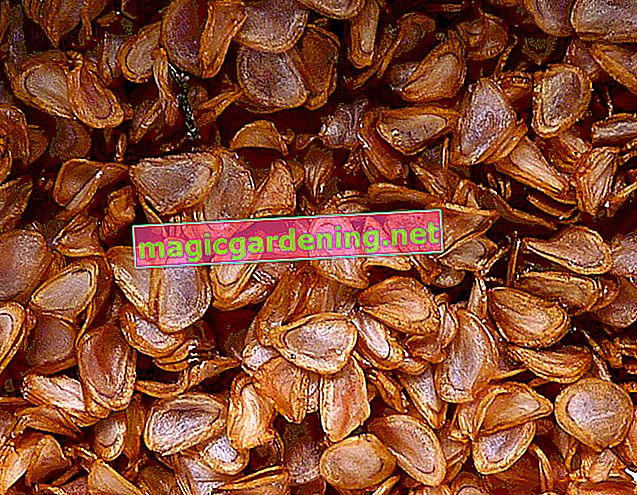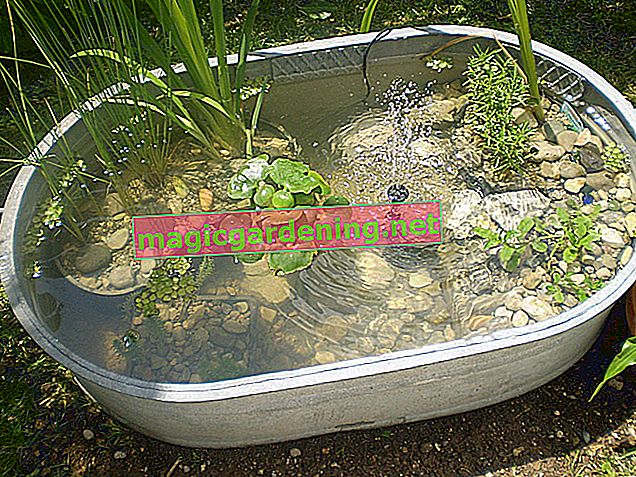
the essentials in brief
- Dipladenia are not hardy and therefore cannot be overwintered outside
- The frost-hardy variety Mandevilla laxa (Chilean jasmine) is an exception.
- The Dipladenia needs light and temperatures between 10 and 15 ° C in winter
- It is not advisable to trim the Dipladenia back before putting it away; which is why the pruning should only be carried out in an emergency
Dipladenia are not hardy
A look at Wikipedia on the distribution areas reveals that the majority of Mandevilla species are native to South America. In the tropical habitats, temperatures below freezing point are almost unknown. Dipladenia are therefore not winter hardy in Central European regions. For this reason, hobby gardeners usually opt for annual cultivation. After the first frost, the summer flowers die and migrate to the compost.
also read
- Are there different types of Dipladenia?
- Can I plant the Dipladenia on my balcony?
- Which location is suitable for the Dipladenia?
In many warm vegetation zones around the globe, Dipladenia species are a familiar sight on streets, in parks and gardens, because the plants thrive here for several years. It is thanks to this fact that the colorful potted plants repeat their flower festival in the Central European climate, provided that they are allowed to overwinter in a species-appropriate manner.
No rule without exception
The only Dipladenia that is frost-tolerant is the pure type Mandevilla laxa, also known as Chilean jasmine. In the course of increasing global warming, the robust plant in Ticino, Switzerland, is already proving to be completely winter-hardy and is planted in many places all year round. It is only a matter of time before the robust Dipladenia species will make the leap over the Alps. In climatically favored wine-growing regions, Chilean jasmine already lingers continuously outdoors, provided that appropriate precautions are taken against severe frost.

Where can Mandevilla hibernate? - Location tips
The Dipladenia needs two things to overwinter:
- sufficient light
- Temperatures between 10 and 15 ° C
If the Dipladenia is too warm in winter, it may not bloom in the following year.
Easily put, to provide a Mandevilla with a light, not full sun and frost-free, not too warm winter quarters. If you allow the tropical plant, the heating season has long since begun indoors. An attempt to convert Dipladenia into a houseplant in cozy, warm living spaces is doomed to failure. The following table lists suitable and unsuitable locations for the wintering of dipladenia behind glass:
| suitable location | unsuitable location |
|---|---|
| House flat | living room |
| bedroom | kitchen |
| basement, cellar | Boiler room / laundry room |
| Winter garden | outside |
| garage | Balcony / terrace |
| Stairwell | Residential hall |
| Glasshouse | |
| Winter tent |
Hibernate the Dipladenia in the cellar
Gardeners who have neither a winter garden nor a frost-free greenhouse at hand often overwinter their Dipladenia in the basement. But this is only a really good option if there is enough light here. The temperatures in the unheated cellar are ideal for the Dipladenia (usually between 11 and 15 ° C), but a lack of light is not good for the Mandevilla. You should therefore only overwinter your Dipladenia in the basement if it can stand near a large window.
Explanations of suitable winter locations
Proud owners of conservatories, greenhouses or glazed terraces do not have to look for long for the ideal winter quarters for Dipladenia. Suitable alternatives are all rooms with bright lighting conditions and a slightly tempered room climate, such as a frost-free garage with windows and plant heating or a light-flooded staircase. In the absence of the options mentioned, it is advisable to invest in a winter tent with a frost guard, under whose protection a beloved Dipladenia can spend the cold season.
Explanations of unsuitable winter locations
A Mandevilla shouldn't take part in the show on the wintry windowsill in a well-heated living room or office. In contrast to the uncrowned winter queen named Amaryllis, Dipladenia cannot cope with a combination of lack of light and warmth. This premise further disqualifies the kitchen, living room and warm basement rooms as a location for the winter in the vicinity of the heating, washing machine and dryer.

Cut back if there is not enough space
Please consider carefully whether to cut back your dipladenie before putting it away. As the growth law of peak promotion teaches us, every cut causes the plant to shoot vigorously. So shortly before the start of wintering, your tropical flower beauty emerges greatly weakened from a cut back. Please only use scissors if the winter location is cramped and otherwise you have no free space. Please note the central shape and maintenance cut for early spring. How to prune a Mandevilla correctly in autumn:
- Put on gloves to protect against the toxic milky juice
- Cover tiles, stone floors with foil or place plants on grass or earth
- Clean up dead flowers
- Shorten excessively long shoots by what is absolutely necessary
Take this opportunity to carefully examine all of the shoots and leaves. Look out for signs of pests such as aphids or scale insects. If you find what you are looking for, fight the lice before moving to winter quarters. High infestation pressure is an argument to cancel the wintering plan so as not to endanger other floral winter guests.
Tips
Dipladenia tend to excrete sticky milky sap in streams from larger cuts. You can easily catch the flow of juice by having small cotton balls or pieces of paper tissues close at hand. After each cut, press a ball onto the wound, no stubborn secretion drips onto the evergreen leaves.
Winter care - tips & tricks
Proper care is one of the pillars of successful wintering of dipladenia. As part of the preparation, you stopped the application of fertilizer and adjusted the watering requirements to the changed requirements. In its winter quarters, the tropical container plant would like these benefits:
- Fill coasters with water as well as expanded clay or grit to increase the local humidity
- Spray leaves once or twice a week with lime-free, room-warm water
- Water occasionally so that the soil does not dry out completely
During the wintering of your Dipladenia, pay a visit at least once a week to meticulously inspect the plant for pests and diseases. At the first signs of an infestation, please isolate the affected Mandevilla from other plants before you devote yourself to adequate control methods.

Prepare for wintering from July - this is how it works
From the end of July you will get your Dipladenia in the mood for the planned wintering. For this purpose, the maintenance program will be modified. From this point on, please do not give any more fertilizer. A stop in the supply of nutrients causes growth to calm down and all shoots to mature. If the plant registers falling temperatures, it stops growing completely and is perfectly prepared for the upcoming winter season.
If the move to winter quarters is imminent in the near future, please water more sparingly. Your Dipladenia is already counted when it is cleared with a damp-wet root ball. Depending on the general conditions at the winter location, evaporation is reduced to a minimum, so that the plant in the pot suffers from wet feet. If the substrate is too moist, root rot and diseases are inevitable.
A combination of lack of light and warmth brings down every Dipladenia in winter quarters
Dipladenia is losing leaves - what to do?
Leaf loss in winter quarters is due to various causes. The following overview indicates the most common triggers for the dropping of leaves with tips for solving problems:
- Lack of light : move to a lighter to sunny location
- Drought stress : Dip the root ball in soft water, let it drain well and water more frequently from now on
- Waterlogging : Do not water or repot in fresh, peat-free substrate for 2-3 weeks
- Cold : move to a place with 8-15 degrees Celsius, away from cold drafts
If your Mandeville sheds dry leaves, the symptom points to both drought stress and waterlogging. To determine the actual cause, please check the substrate with a thumb test. Press your finger an inch or two into the soil. If you do not feel any moisture, watering is required. Perceptible wetness indicates waterlogging. The guesswork is gone when you stick a moisture meter into the substrate.
Control aphids in their winter quarters
In the winter quarters of evergreen dipladenia, aphids lie in wait to attack the lush green leaves. The potted plants often have the rabble in their luggage when they move from the balcony. The tiny pests hide cheekily on the underside of the leaves or leaf axils and hope to escape the gardener's attention. A few specimens are enough to multiply explosively. How to control aphids with a simple home remedy:
- Pack the root ball in a plastic bag
- Rinse the plant vigorously, ideally also upside down
- Boil 1 liter of water and allow to cool
- Stir in 20-30 grams of pure curd soap with 1-2 spritzes of alcohol
- fill into a spray bottle
- Spray Dipladenia every 3-4 days (please do not forget the underside of the leaf)
In the fight against aphids, soap solution has proven to be unbeatably effective and puts all chemical agents in the shade. Various manufacturers offer the tried and tested home remedy ready-made, such as Neudorff with Neudosan aphid-free AF or Naturen with organic pest-free AF.
Beautiful species - differentiated cold tolerance

A colorful array of beautiful species leaves nothing to be desired to decorate the bed, balcony and terrace with dipshops. The selection ranges from compact, small varieties to majestic climbing plants for facade greening. With regard to the short-term temperature minimum, the diversity shrinks to a minimum, as the following table shows:
| Surname | Flower color | short-term temperature minimum | Winter temperature |
|---|---|---|---|
| Mandevilla Sundaville red | red | 0 degrees Celsius | 8 to 15 degrees Celsius |
| Mandevilla Sundaville white pyramid | White | 0 degrees Celsius | 8 to 15 degrees Celsius |
| Dipladenia Crimson red | red, later fading to pink | 0 degrees Celsius | 8 to 15 degrees Celsius |
| Dipladenia Diamantina Opale Citrine | yellow | 0 degrees Celsius | 8 to 15 degrees Celsius |
| Mandevilla laxa Chilean jasmine | White | - 10 degrees Celsius | 0 to -5 / -8 degrees Celsius |
| Dipladenia Hybrida Rio deep red | deep red | 5 degrees Celsius | 15 to 18 degrees Celsius |
Explanations of species and varieties
Dipladenia with the variety name Sundaville are hybrids that are descended from the species Mandevilla sanderi. Japanese growers have succeeded in creating the magnificently flowering varieties, which can be discovered ready-made as a pyramid, on a trellis or hanging in a pot in garden centers from May. In addition to the popular white and red varieties, the series also offers yellow, apricot or pink flowering hybrids. For gardeners with a penchant for colorful pots, the Sundaville family has the Tricolor variety with white, pink and red funnel-shaped flowers ready.
The varieties of the Diamantine series from the hands of French breeders are causing a sensation. As a representative of the wide range of varieties, the table above lists Opale Citrine, the world's first yellow Dipladenia. Another sensation with bright orange blossoms followed in 2016 with Opale Orange Coral. For cultivation in flower boxes or beds, we recommend the small-stature Diamanta varieties from the Jade series, which give off creative design ideas with red, pink, white, yellow or striped flowers.
Digression
Wintering for pompous Dipladenia is worthwhile
Far more than half of all Dipladenia species and varieties sold impress with their compact growth and lush flowers. The growth of long tendrils is avoided if possible. Thanks to a treatment with growth inhibitors, the beauties of the flowers remain at a height of 20 to 40 centimeters, ideal for the summery decoration of flower beds, graves and window boxes. (€ 106.25 at Amazon *) Many years of gardening practice has proven that the effort of wintering is only worthwhile for magnificent, voluminous dip shops, which the grower prefers to start the season on the trellis with a height of at least 40 to 80 centimeters. Experts from the renowned Mein-Schöne-Garten online shop confirm these experiences.Allow Dipladenia in good time
If you cultivate dipladenia in pots or tubs with an integrated climbing aid, this foresight proves to be practical for uncomplicated and time-saving storage. Fix a minimum-maximum thermometer near the location, determine the right time to winterize the cold-sensitive plants. If the temperatures drop below 8 degrees Celsius even at night, the starting signal is given for wintering. Mandevillen can only cope with a temperature minimum of 0 degrees Celsius for a short time. A whole night below freezing point significantly affects the chances of success for a multi-year cultivation. This is how the winter quarters should be:
- bright, but without direct sunlight
- slightly tempered with 8 to 15 degrees Celsius
- sufficiently away from cold drafts through doors or tilted windows
If it is too dark in the winter location, there is a risk of yellow leaves and leaf loss. As a late consequence, the flowering time is delayed by several weeks in the next spring, because the leafless Dipladenia first has to take care of growing a new foliage. You can prevent this by using special lighting. Dipladenia friends report good experiences with a plant lamp that uses an LED spotlight to immerse the location in a plant-specific blue / red light spectrum.
YoutubeSpecial case Mandevilla laxa (Chilean jasmine)
The limited frost tolerance of Mandevilla laxa allows wintering outdoors in mild winter regions of the hardiness zone Z8. In wine-growing regions, on the Lower Rhine or in gardens with an adequate microclimate, you do not necessarily have to leave the container plant. Before the first frost, thickly wrapped in a coat made of winter fleece and placed on an insulating wooden base, there is a good chance that the winter will remain intact.
Winter out gradually
The end of winter time means for a Dipladenia that it has to make arrangements with serious differences between winter quarters and outdoor locations. An abrupt change of location brings the beauty of the tropics to its limits and is not infrequently acknowledged with the failure of the flowering period. By gradually wintering a Mandevilla, you skilfully avoid this problem. How to do it right:
- Starting at the end of March / beginning of April, give a liquid flower fertilizer (€ 13.27 on Amazon *) every week
- Water more often with low-lime water for a slightly moist substrate
- From the beginning / middle of May, place the plant in a partially shaded, warm location during the day
- put away behind glass overnight
- set up after 8 to 10 days in full sun for summer time
The end of the winter does not mean that you can put the impending danger from pests or diseases aside. On the contrary, flocks of aphids are on hand at the start of the new season to feast on the juicy leaves of your Dipladenia. Please continue the controls seamlessly in order to take countermeasures in good time.
Seasonal prologue - repot and cut Dipladenia
So that a wintered Dipladenia shows its most splendid side again, set the course with a well-planned seasonal prologue. Growth gets going by repotting the plant in fresh substrate and cutting. Both measures are explained in more detail below:
Repot
A high-quality potted plant soil without peat is suitable as a substrate. Alternatively, Mandevillas thrive splendidly in a mix of conventional potting soil and coconut soil in equal parts, enriched with expanded clay (€ 17.50 on Amazon *) or lava granules. Some potsherds on the bottom of the pot act as drainage to protect against waterlogging. Before potting the climbing plant, detach the tendrils from the climbing aid. Then shake off the used soil, pot the plant in fresh soil and attach the shoots to the trellis again.
To cut
Switching to fresh substrate is the perfect opportunity to cut a hibernated Dipladenia. Thanks to an excellent pruning tolerance, it is up to your horticultural assessment to what extent you carry out the pruning. Please keep in mind that the more radically you cut the delayed the start of flowering. Protect your hands, clothing and floor from the sticky, milky sap. Preferably use sharp, disinfected secateurs with a bypass mechanism. Please dispose of the slightly toxic clippings out of the reach of children and pets.
frequently asked Questions
Can a Dipladenia hibernate outside?
In view of the minimum temperature of 0 to 8 degrees Celsius, you cannot overwinter a Dipladenia outdoors even in wine-growing regions with mild winter conditions. In its tropical home regions, the splendid summer beauty naturally thrives outdoors all year round as a perennial climbing plant. In the Central European climate, the horticultural masterpiece only succeeds in frost-free, bright winter quarters behind glass. The only exception to the rule applies to Mandevilla laxa, which can overwinter outside in winter hardiness zone Z8, provided that appropriate protective measures are taken.
Are Dipladenia Poisonous?
Dipladenia belong to the dog poison family. Characteristic of all species and varieties is a poisonous milky sap that emerges from wounds on shoots and leaves. The white, sticky secretion contains various toxins that are dangerous for humans and animals. Direct skin contact can cause allergies and eczema. Intentional or unintentional consumption causes nausea and vomiting.
Can I keep a Dipladenia warm in the pot on the windowsill in the living room?
It is easy to understand that you want to continue to enjoy the splendid flower dress of your Dipladenie in winter. Here, however, the wish is the father of the thought. The Mediterranean serenity is achieved when you treat the plant during the dark season with temperatures above 15 degrees Celsius. Mandevilla acknowledge a constellation of lack of light and cozy room warmth with the failure of the next flowering period or they die. A recommended alternative is a place on the light-flooded window sill in the slightly tempered bedroom.
Why is my overwintered Dipladenia still not blooming in June?
Various causes delay the beginning of the flowering period on overwintered dipladenia. From the second year and after pruning in spring, the plants have to cope with increased vegetative growth. Often, Mandevilla received too little fertilizer the year before. To ensure that sufficient energy reserves are available for a renewed flowering period, please apply 20 to 30 grams of long-term fertilizer for every 5 liters of substrate volume from March to the end of July. Alternatively, add a liquid flower fertilizer to the irrigation water every week during the growing season.
What to look for when pouring Dipladenia
Dipladenia thrive with a beet-shaped root as a storage organ for water. This results in moderate to low water consumption, because the substrate should only be slightly damp. In summer it is completely sufficient to water the plant once or twice a week, provided that the surface of the soil is noticeably dry. If you overwinter a Dipladenia, the watering requirement drops to occasional watering so that the soil does not dry out completely. Use water that is low in lime and lukewarm.
Why do the leaves of my overwintered Dipladenia turn yellow?
If there is a Dipladenia with yellow leaves in winter quarters, three causes come into focus. If the location is too dark and warm, the plant draws in its leaves to hope for better times. Furthermore, hard, calcareous irrigation water in the substrate causes the pH value to skyrocket. As a result, the Mandevilla suffers from leaf chlorosis, recognizable by the yellow discolored leaves. Suddenly moving from winter quarters to full sunshine causes sunburn on the evergreen leaves. It starts with yellow spots that will spread quickly if you don't shade the plant for a few days to allow it to get used to the sun's rays.
Should a Dipladenia be repotted after each wintering?
Annual repotting is not mandatory for overwintered dipladenia. Only when the roots push through the substrate or grow out of the opening in the ground due to a lack of space can you no longer avoid the measure. So that the start of this year's flowering period is not unnecessarily delayed, the new pot must not be too large. There should be a maximum of two fingers' widths between the root ball and the vessel wall.
Tips
In the twinkling of an eye, a vigorous Dipladenia climbs its climbing support to dizzying heights. The shadows cast by the dense foliage and flowers make the foot of the tub plant bald. With a small-growing variety as an underplant, you can restore the seamless bloom. Large and small Mandevillas move together to suitable winter quarters in autumn.








